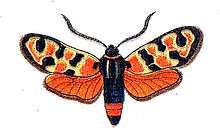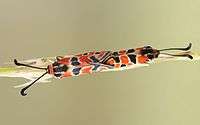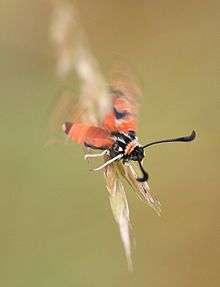Zygaena fausta
| Zygaena fausta | |
|---|---|
 | |
| Illustration by Jacob Hübner | |
| Scientific classification | |
| Kingdom: | Animalia |
| Subkingdom: | Eumetazoa |
| Phylum: | Arthropoda |
| Subphylum: | Hexapoda |
| Class: | Insecta |
| Order: | Lepidoptera |
| Division: | Ditrysia |
| Family: | Zygaenidae |
| Genus: | Zygaena |
| Species: | Z. fausta |
| Binomial name | |
| Zygaena fausta (Linnaeus, 1767) | |
| Synonyms | |
| |




Zygaena fausta is a member of the Zygaenidae family, the day-flying burnet moths. Its bright aposematic colours of red, white and black on the wings indicate to possible predators such as birds that it is foul tasting or poisonous. In flight, the bright red abdomen is revealed, contrasting with the white legs and black head and antennae; the thorax is black and white with an eye spot on each side (see image). There appears to be a considerable variation in pattern among specimens from different parts of Europe.
It is distributed on western Europe including Spain, France, northern Italy, Switzerland, Austria and southern and central Germany.[1]
It is rare or absent from Britain, the Netherlands and Belgium, where related species include the similarly aposematic five-spot burnet and the six-spot burnet.[2]
The caterpillar (larva) is dark grey with a black line above a line of white interrupted by yellow bands. The caterpillar's food plants are vetches of the genus Coronilla.[3]
The adults often visit a wide range of flowers including knapweed and eryngo. Typical habitat is dry chalk grassland. Adults fly throughout the summer from April or May until October. The sexes are similar but not identical (see image); mating takes place by day on isolated plants.
Subspecies
- Zygaena fausta fausta
- Zygaena fausta agilis Reiss, 1932
- Zygaena fausta alpiummicans Verity, 1926
- Zygaena fausta baetica Rambur, 1839
- Zygaena fausta fassnidgei Tremewan & Manley, 1965
- Zygaena fausta faustina Ochsenheimer, 1808
- Zygaena fausta fernan Agenjo, 1948
- Zygaena fausta fina Burgeff, 1956
- Zygaena fausta fortunata Rambur, 1866
- Zygaena fausta gibraltarica Tremewan, 1961
- Zygaena fausta jucunda Meisner, 1818
- Zygaena fausta junceae Oberthur, 1884
- Zygaena fausta lacrymans Burgeff, 1914
- Zygaena fausta murciensis Reiss, 1922
- Zygaena fausta preciosa Reiss, 1920
- Zygaena fausta suevica Reiss, 1920
References
- ↑ Interactive map, Encyclopedia of Life, http://www.eol.org/pages/379460
- ↑ SoortenBank.nl, ETI BioInformatics, http://www.soortenbank.nl/soorten.php?soortengroep=insecten&id=1062
- ↑ Moths and Butterflies of Europe and North Africa, by Paolo Mazzei, Daniel Morel, Raniero Panfili, Ilaria Pimpinelli, Diego Reggianti. http://www.leps.it/indexjs.htm?SpeciesPages/ZygaeLaeta.htm